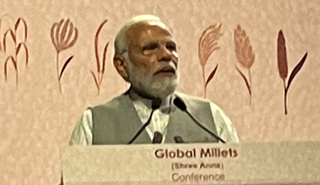The UN has declared 2023 ‘International Year of Millets’. But what even is millet and why are University of Reading scientists and the Indian Prime Minister so interested?
Professor Ian Givens, Director of the University of Reading Institute for Food, Nutrition and Health – a centre for nutrition research, from farm to fork – was the UK representative at a Global Millets meeting in Delhi. The opening speechby the Indian Prime Minister Narendra Modi proclaimed the benefits of millets for health and the environment.
Professor Givens was invited by the Food Safety and Standards Authority of India to give two presentations on the nutrition and health characteristics of millets. He said: “Food security is a major global concern, right now. We must ensure that sustainable production equals sustainable nutrition. This is true across the world but in areas that are most affected by a warmer, drier climate, the challenge is especially great and demands some big changes.
“Having enough calories is only part of the picture. Those calories need to come from foods that also provide a good range of essential macro and micronutrients.
“Given all of these parameters, we really have to look to millets. They grow well in semi-arid conditions and are nutritionally better than the traditional Indian staples of rice, wheat and maize. We might even see millets on western dinner tables as, unlike rice, millets will grow well in the UK climate, reducing imports and lowering food miles.”
The event was organised by the Indian Ministry of Health and Family Welfare and was attended by scientists from around the world.
Millets are a type of small grain cereals and comprise a wide range of types. They grow well in semi-arid conditions, making it more resistant to the impacts of climate change. Millets are a good alternative to rice because they generally have a higher energy content and and are significantly higher in protein, while providing more micronutrients, such as calcium and iron, as well as providing more dietary fibre.
The grains are smaller than most traditional staple grains and can be cooked like rice. Millets are staple foods with a mild flavour and pleasant texture and are an important part of the diet in semi-arid regions of the world, including the Indian subcontinent. In India, it is hoped that millets will increasingly replace rice, wheat and maize. There are other preparations and uses for millet, including sweet treats made by ‘puffing’ the grains; alcoholic beverages such as the distilled spirit, Rakshi; and porridge.

